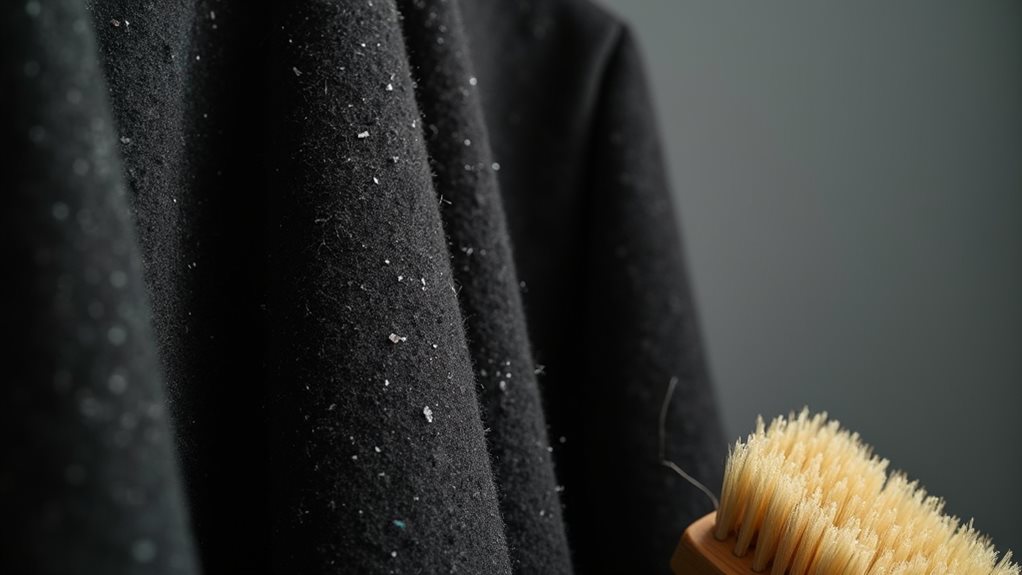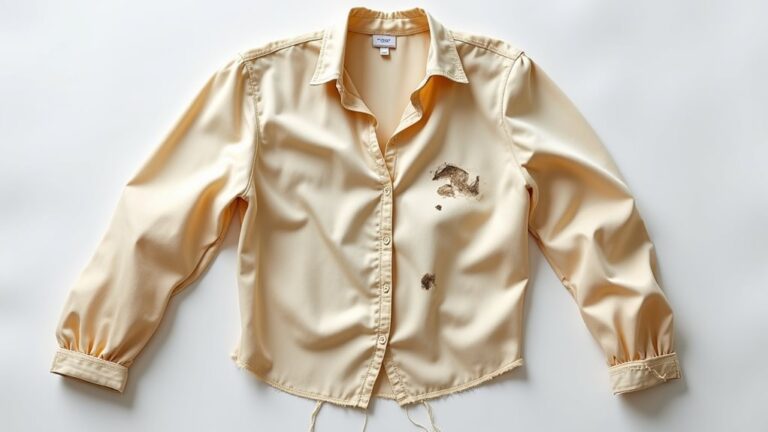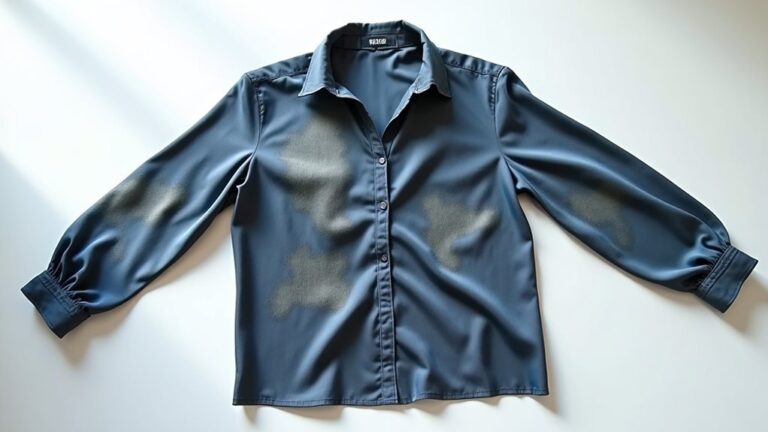Yes, dry cleaning effectively removes dust from your garments, often better than traditional washing. The chemical solvents penetrate fabric fibers more thoroughly than water, lifting embedded dust particles without the mechanical agitation that can damage delicate materials. Since dry cleaning doesn’t saturate fabrics like water does, it prevents the swelling that complicates dust removal in regular washing. You’ll find this method particularly beneficial for preserving your garment’s texture while guaranteeing extensive dust elimination that reveals additional professional techniques.
What Is Dry Cleaning and How Does It Work?
When I first discovered dry cleaning during my college years, I’ll admit I was completely mystified by how clothes could get “cleaned” without actually getting wet – it seemed like some kind of laundry magic that only fancy people understood.
I thought dry cleaning was some mysterious fancy-people magic until I learned it’s just chemistry doing the heavy lifting.
Now I know that dry cleaning work involves liquid solvents instead of water, making it one of the most effective cleaning processes for preserving your wardrobe investments.
The process starts with careful inspection and tagging, followed by pre-treating visible spots before your garments enter the machine.
These chemical solvents circulate through delicate fabrics, dissolving oils and dirt while being continuously filtered for ideal results.
Professional cleaning like this can remove stains and particles that traditional washing simply can’t handle safely! 😊
After the solvent bath, garments go through drying and pressing to restore their original appearance and shape, which is especially important for structured garments like suits and formal wear.
Why Dust Accumulates in Different Types of Fabrics
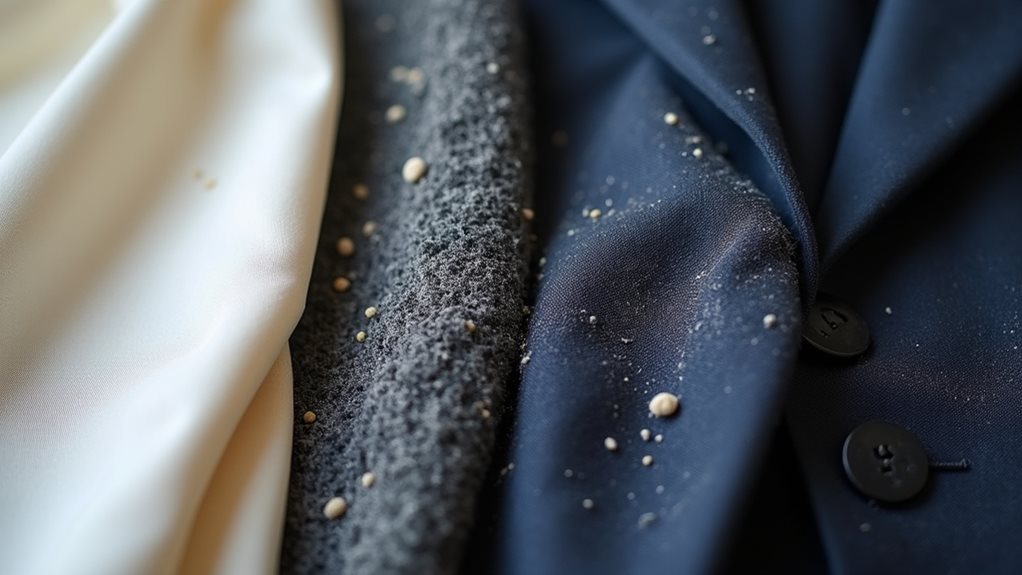
You’ve probably noticed how your favorite velvet blazer seems to be a dust magnet compared to that sleek silk blouse hanging right next to it.
There’s actually fascinating science behind why certain fabrics collect more dust than others. The way your clothes are woven, whether they’re made from static-prone synthetic fibers or natural materials, and even the invisible electrical charges dancing around your home all play starring roles in this daily dust drama that unfolds in your closet.
Understanding these factors—from the microscopic structure of different fabric weaves to the environmental dust sources swirling through your living space—will help you make smarter choices about both your wardrobe and cleaning routine. 🧵
Fabric Weave and Structure
Three fundamental factors determine how much dust your favorite garments will collect, and understanding these characteristics can save you countless trips to the dry cleaner while keeping your wardrobe looking fresh.
Your fabric weave and structure play the starring role in this dust-collecting drama – think of tighter weaves like silk and polyester as your dust-resistant heroes, while looser weaves such as cotton and linen become dust magnets 🧲.
When proper cleaning becomes necessary, dry cleaning removes embedded particles effectively because cleaning solvents penetrate these intricate fiber patterns better than water-based methods.
The weave density fundamentally determines whether dust finds cozy hiding spots or slides right off, making some fabrics naturally low-maintenance while others require more frequent professional attention to remove dirt and maintain their appearance.
This specialized cleaning approach also prevents structural damage that water-based washing might cause to delicate fabric constructions, ensuring your garments maintain their original weave integrity while becoming thoroughly dust-free.
Static Electricity Effects
Although fabric weave sets the stage for dust collection, static electricity acts as the invisible force that actually pulls those pesky particles toward your clothes like a magnet you can’t see.
You’ve probably noticed how your polyester blouse attracts every speck of lint in sight, while your cotton shirt stays relatively clean – that’s static electricity at work!
Synthetic fabrics build up electrical charges that create this dust-grabbing effect, especially in dry environments where humidity can’t help dissipate the charge.
The rougher your fabric texture, the more surface area you’re giving static electricity to work with, which means more dust accumulation over time.
Fortunately, dry cleaning as a cleaning method can help reset these electrical charges, giving your clothes a fresh start against future dust battles.
However, traditional dry cleaning processes use chemical solvents like perchloroethylene that may leave residues on fabrics, so it’s important to let freshly cleaned garments air out properly before wearing.
Environmental Dust Sources
While static electricity draws dust particles to your fabrics, the real question becomes where all this dust originates in the first place, and honestly, the answer might surprise you – it’s literally everywhere around us!
Your outdoor environment constantly bombards your home with pollen, soil particles, and vehicle emissions that sneak inside on your clothes, shoes, and through open windows.
Meanwhile, your indoor spaces generate their own dust factory from skin cells (yes, we’re constantly shedding!), pet dander, hair, and clothing fibers.
What’s fascinating is how different fabrics become dust magnets differently – your velvet curtains trap way more particles than sleek polyester because of their texture.
This is exactly why dry cleaning becomes so effective; it can remove deeply embedded dust that regular cleaning methods simply can’t reach, tackling both dust and stubborn stains.
The chemical solvents used in dry cleaning processes can penetrate fabric fibers more effectively than water-based methods, making them particularly valuable for removing particles from delicate materials like silk and wool.
How Dry Cleaning Solvents Target and Remove Dust Particles
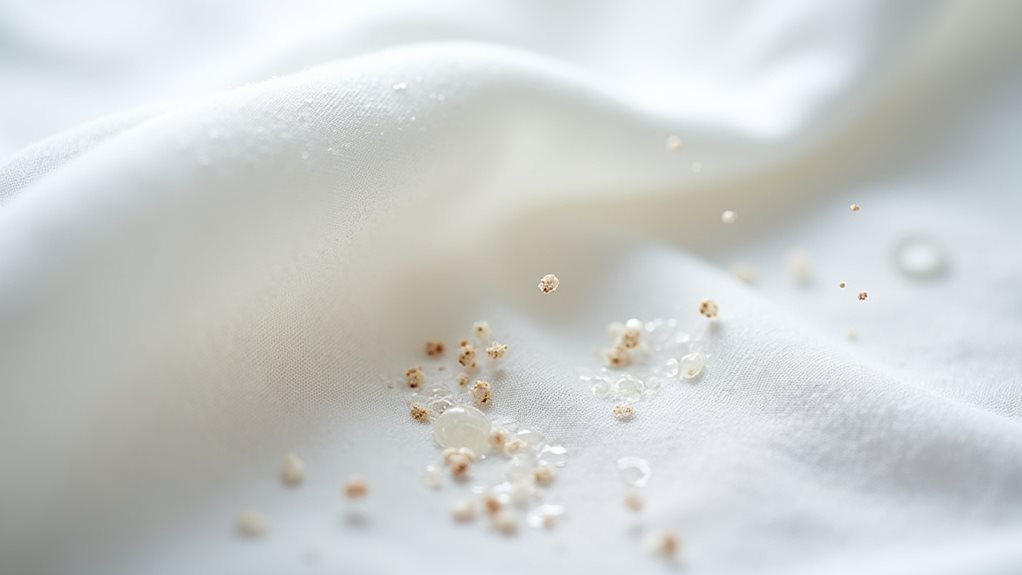
When I first discovered how dry cleaning actually works, I felt like I’d uncovered some kind of textile magic – and honestly, the science behind it’s pretty fascinating.
The science behind dry cleaning feels like discovering textile magic – fascinating chemistry that most people never think about.
Here’s what really happens: dry cleaning solvent cleans by penetrating deep into fabric fibers, where it literally dissolves dust particles that water simply can’t reach.
Unlike regular washing that makes fibers swell and trap dirt, these specialized chemicals slip right through, breaking down oils and grime that hold dust in place.
The best cleaning happens because the solvent gets continuously filtered during the process, capturing every loosened particle.
For garments needing special care, this method removes dust while preserving delicate textures, and it’s surprisingly effective at helping remove stains too.
This specialized approach is particularly valuable for delicate fabrics like silk, wool, and cashmere that would be damaged by traditional water-based washing methods.
Comparing Dust Removal: Dry Cleaning Vs Traditional Washing

When you’re deciding between dry cleaning and throwing your dusty blazer in the washing machine, you’re fundamentally choosing between two completely different dust-busting approaches that each have their own strengths and quirks.
Dry cleaning uses chemical solvents that gently coax dust away without the aggressive tumbling action, while traditional washing releases water, detergent, and mechanical agitation to literally flush particles out of every fiber—think of it like comparing a careful dusting with a feather versus hosing down your patio furniture.
The real kicker is that while water-based washing might seem more thorough for dust removal, it can also turn your favorite silk shirt into something resembling a dishrag, which is where dry cleaning’s fabric-protection capabilities really shine. 💪
The chemical solvents used in dry cleaning, particularly perchloroethylene or newer eco-friendly alternatives, are specifically designed to dissolve oils and particles that water-based methods struggle to remove effectively.
Dust Extraction Methods
Two distinct approaches exist for removing dust from your clothing, and honestly, I spent years thinking they were pretty much the same until my favorite cashmere sweater taught me otherwise.
Traditional washing relies on water and detergent to tackle grime, but here’s the thing – water can actually cause fabric fibers to swell, trapping dust particles deeper inside.
Dry cleaners use chemical solvents that dissolve dirt without soaking your garments, which makes them incredibly effective at lifting stubborn dust from delicate materials.
The agitation and filtration process literally pulls particles out of non-washable fabrics like wool and silk, creating a cleaner environment in your closet.
This specialized cleaning method also provides professional pressing that restores your garments to their original crisp appearance after dust removal.
Trust me, once you see how effectively dry cleaning removes dust, you’ll understand why some garments deserve this special treatment!
Solvent Versus Water
Although I’ve always been fascinated by the science behind cleaning methods, it wasn’t until I accidentally ruined my grandmother’s vintage silk scarf with regular laundry detergent that I truly understood the fundamental difference between solvents and water.
When you dry clean fabric, the chemical solvent dissolves oils and dust particles that water simply can’t touch, while traditional washing often causes fibers to swell and trap debris inside.
The solvent removes dust more effectively because it doesn’t saturate your delicate garments, maintaining their integrity while lifting away allergens and particles.
Think of it this way: water is like trying to clean with mittens on, while dry cleaning solvent works with surgical precision, targeting exactly what needs to go.
The process begins with garment inspection and pre-treatment of visible stains before immersion in specialized solvents like perchloroethylene within industrial machines that agitate and circulate the cleaning fluid.
Fabric Protection Benefits
Beyond just removing dust more effectively, dry cleaning acts like a protective shield for your favorite fabrics, something I learned the hard way after watching my expensive wool coat become a misshapen mess in my washing machine.
The gentle chemical solvents don’t just lift dust particles; they actually preserve delicate fibers that water and agitation would destroy.
While your standard home washing might seem convenient, dry cleaning actually removes stains and allergens without the harsh mechanical action that breaks down silk, cashmere, and intricate weaves.
Professional cleaners inspect every garment thoroughly, using specialized techniques to guarantee the garment maintains its original texture and appearance.
When you pick up your freshly cleaned items, you’re getting dust removal plus fabric preservation.
These specialized solvents like perchloroethylene effectively dissolve oils and stains without causing the structural damage that water-based cleaning methods inflict on sensitive materials.
Which Garments Benefit Most From Dry Cleaning for Dust Removal

Regular dry cleaning maintains these items’ pristine appearance while guaranteeing peak cleanliness, preserving both their structure and your sanity when getting dressed matters most. Delicate fabrics like silk, wool, and cashmere require chemical solvents instead of water-based cleaning to prevent shrinkage and maintain their texture during dust removal.
Professional Techniques That Maximize Dust Elimination
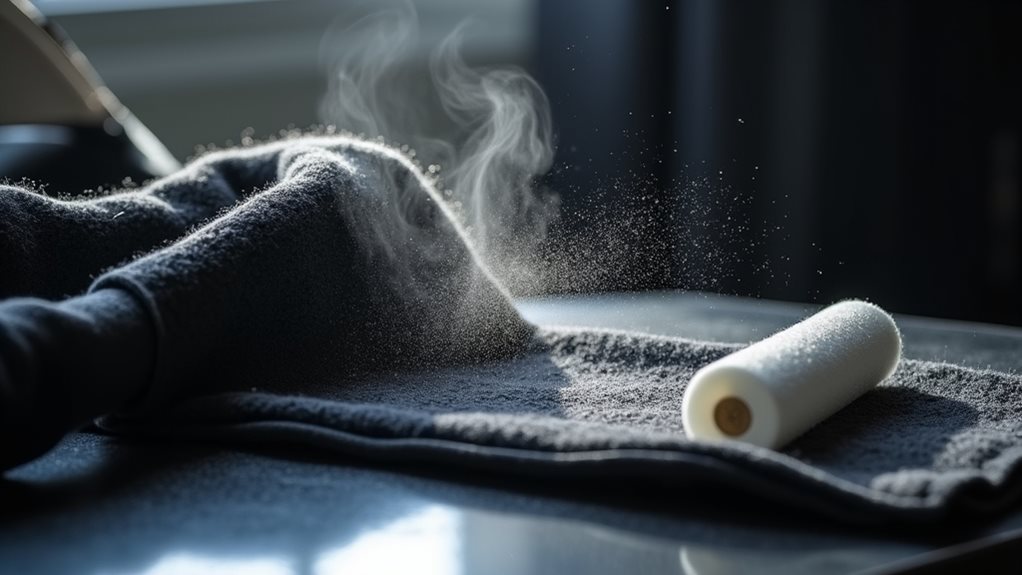
When professional dry cleaners get their hands on your dusty garments, they’re armed with specialized solvents that work like tiny molecular magnets, pulling particles from fabric fibers in ways your home washing machine simply can’t match.
Professional dry cleaners wield specialized solvents like molecular magnets, extracting particles from fabric fibers with precision your home washer can’t achieve.
These experts use solvent instead of water, which honestly makes me feel a bit envious of their chemical wizardry 🧪. Their thorough garment inspection process catches dust accumulation in places you’d never notice, like those sneaky pocket creases.
The real magic happens with their advanced equipment that continuously filters and purifies solvents during cleaning cycles, guaranteeing dust particles don’t just relocate to different fabric areas.
This systematic approach, combined with proper circulation techniques, creates a dust-elimination process that’s genuinely impressive and consistently effective.
Tips for Maintaining Dust-Free Garments Between Cleanings

While professional dry cleaners work absolute magic with their molecular wizardry, you don’t have to sit helplessly watching dust bunnies colonize your favorite blazer between cleaning appointments.
I’ve learned through countless closet catastrophes that simple daily habits make all the difference in preventing dust accumulation.
Your maintenance arsenal should include:
- Regular lint brush sessions – A quick brushing after each wear removes surface particles before they settle in
- Breathable garment bags – These protective covers shield delicate fabrics while allowing air circulation
- Strategic vacuum cleaner use – Gently clean hanging garments with an upholstery attachment monthly
Keep your well-ventilated closet clean and dust-free, because trust me, prevention beats frantically googling “emergency stain removal” at midnight! 😅

